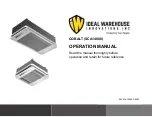
Page 23
B- Indoor Blower Motor
FIGURE 6
Power Choke
(4 and 5 Ton Only)
Blower Motor
(B3)
To Remove Blower From Unit: Remove access panels,
Control box, Bolts and Wiring Jackplugs.
Then Slide Out Front of Unit.
WARNING
During blower operation, the ECM motor emits ener
gy that may interfere with pacemaker operation. In
terference is reduced by both the sheet metal cabinet
and distance.
The motor communicates with the integrated control via a
2-way serial connection. The motor receives all necessary
functional parameters from the integrated control and does
not rely on a factory program like traditional variable speed
motors. SL280UHNV units use a three‐phase, electronically
controlled D.C. brushless motor (controller converts single
phase a.c. to three phase D.C.), with a permanent‐magnet‐
type rotor (figure 7). Because this motor has a permanent
magnet rotor it does not need brushes like conventional D.C.
motors.
The stator windings are split into three poles which are electri
cally connected to the controller. This arrangement allows
motor windings to turn on and off in sequence by the con
troller.
IMPORTANT
Earlier ECM motors used on other Lennox furnace
models are not interchangeable with motors used on
the SL280UHNV furnace line.
A solid‐state controller is permanently attached to the
motor. The controller is primarily an A.C. to D.C. con
verter. Converted D.C. power is used to drive the motor.
The controller contains a microprocessor which moni
tors varying conditions inside the motor (such as motor
workload).
BLOWER MOTOR COMPONENTS
FIGURE 7
STATOR
(WINDINGS)
BEARING
ROTOR
The controller uses sensing devices to sense what position
the rotor is in at any given time. By sensing the position of the
rotor and then switching the motor windings on and off in se
quence, the rotor shaft turns the blower.
All SL280UHNV blower motors use single phase power.
An external run capacitor is not used. The motor uses
permanently lubricated ball‐type bearings.
Internal Operation
The motor is controlled via serial communication between
the integrated control on the furnace and the controller at
tached to the motor shell. The messages sent back and
forth between the two controls serve to communicate rota
tional direction, demand, motor size, current draw, torque,
and rpm, among other variables.
Motor rpm is continually adjusted internally to maintain
constant static pressure against the blower wheel. The control
ler monitors the static work load on the motor and motor amp‐
draw to determine the amount of rpm adjustment. Blower rpm
may be adjusted any amount in order to maintain a constant
cfm as shown in Blower Ratings Tables. The cfm remains rel
atively stable over a broad range of static pressure. Since the
blower constantly adjusts rpm to maintain a specified cfm, mo
tor rpm is not rated. Hence, the terms “cool speed”, “heat
speed ” or “speed tap” in this manual, on the unit wiring dia
gram and on blower B3, refer to blower cfm regardless of mo
tor rpm.
Initial Power Up
When line voltage is applied to B3, there will be a large inrush
of power lasting less than 1/4 second. This inrush charges a
bank of DC filter capacitors inside the controller. If the discon
nect switch is bounced when the disconnect is closed, the dis
connect contacts may become welded. Try not to bounce the
disconnect switch when applying power to the unit.
















































